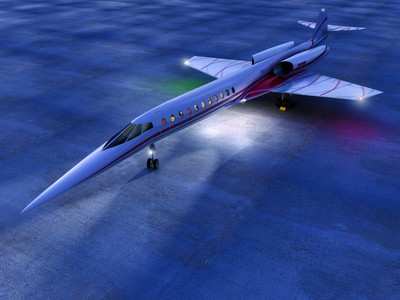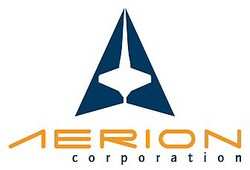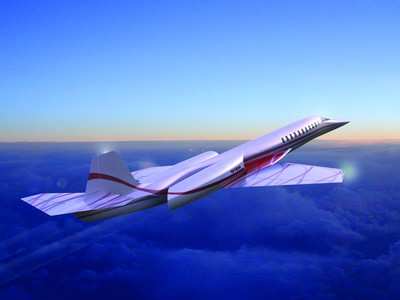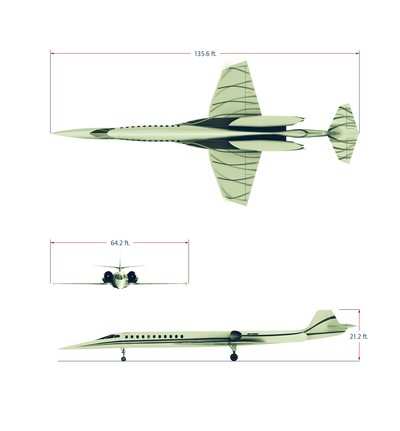Confirms Viability of its SBJ Design
One year after its public unveiling, Aerion has completed its
Phase 1 design program, arriving at an aircraft configuration whose
technical viability has been confirmed through extensive wind
tunnel testing and computer analysis. Aerion has also completed a
wide-ranging market study confirming demand for this design. The
business and engineering objectives announced last year have been
validated.

"We are keeping to an aggressive timeline moving toward routine
supersonic business jet travel," said Aerion Vice Chairman Brian
Barents. "The major questions about the technical feasibility of
this objective have been answered and we are now able to present to
potential partners a design that is well researched and quite
achievable."
The Aerion SBJ design presented last year was already the
product of years of preliminary design by Aerion and predecessor
companies. Since then, Aerion has further analyzed performance,
stability, noise, cockpit visibility and other requirements to
ensure a certifiable design. In the process, the shape of wings,
fuselage, strakes, nacelles and empennage have been refined and
tested. Aerion expects little to change at this point in terms of
external configuration.

Earlier this year, Aerion completed proprietary market research
with the operators of more than 1,100 global-class business jets.
The study, which included a survey of more than 100 executive and
flight department decision makers, confirms demand for 250-300
Aerion SBJ aircraft in the first ten years of production.
Among the design changes in the past year:
-
 The cockpit floor has been elevated,
the windshield angle changed and the nose shape slightly altered in
order to ensure the Aerion SBJ meets FAA guidelines for pilot
visibility. No artificial vision systems or mechanical nose droop
systems will be required to ensure good visibility on approach or
during ground operations.
The cockpit floor has been elevated,
the windshield angle changed and the nose shape slightly altered in
order to ensure the Aerion SBJ meets FAA guidelines for pilot
visibility. No artificial vision systems or mechanical nose droop
systems will be required to ensure good visibility on approach or
during ground operations.
- The nose gear has been moved farther aft so that it is
positioned under the cockpit floor. Turning radius has been reduced
to less than 75 feet for improved maneuvering on ramps and
taxiways.
- Fuselage shape has been refined, with a vertical oval cross
section in the forward cabin area expanding to a circular constant
cross section in the cabin seating area. The tapered cross section
provides the optimum combination of good high-speed aerodynamics
and super-midsize cabin comfort.
- A flat floor will run throughout the cabin from cockpit to rear
pressure bulkhead. Aisle height in the constant cross section area
has been reduced from 6.3 to 6 feet to increase floor width to 4.4
feet. Cabin width remains 6.6 feet. Cabin length is 30 feet,
allowing for up to three seating areas, plus galley and
lavatory.
- Maximum takeoff weight has remained at or below 90,000 pounds,
while wing area has been reduced from 1,400 square feet to 1,200
square feet. Balanced field length remains less than 6,000
feet.
- Wing geometry has changed slightly. In addition to the
reduction of area, aspect ratio has increased from 3.0 to 3.3. Tip
chord has increased and raked tips have been added. The root chord
has decreased and the leading edge sweep reduced locally at the
intersection with the strake.
- Trailing edge flaps will serve as flaperons for roll control,
and have been improved with the addition of split flaps to further
enhance low speed capability and reduce deck angle on
approach.
- Leading edge strakes have been modified to provide improved
low-speed stall characteristics while maintaining both low-speed
and supersonic drag levels.
- Nacelle design has undergone significant refinement. The
earlier rectangular inlet shape has changed to a nearly circular,
highly efficient inlet.
- The horizontal tail has been changed from a T-tail to a
conventional vertical and low-mounted cruciform tail configuration.
These changes provide improved stall characteristics and increased
tail power for stall prevention and recovery.
- The Aerion SBJ will have a fly-by-wire flight control system to
reduce weight, complexity and maintenance. It will employ mild
stability augmentation to enhance stability and handling
characteristics across the aircraft's broad speed range.
The Aerion SBJ has excellent efficiency just below Mach 1,
presently the legal maximum for flight over the U.S. and thus can
cruise at higher speeds than subsonic jets. Elsewhere in the world,
no-boom flight over populated areas is permitted. Studies show that
the cruise speeds near Mach 1.15 avoid any perceptible boom at
ground level. Unrestricted speeds are permitted over designated
routes in many sparsely populated regions such as Northern Canada,
Siberia and Australia. At supersonic cruise speed, the Aerion SBJ's
sonic boom characteristics are relatively mild because of the
aircraft's low weight.

"As we move into serious discussions with potential partners,
the test results to date give us great confidence that the Aerion
SBJ is an achievable dream," commented Chairman Robert Bass.

"Indeed, both the technical case and the business case are quite
compelling."
 ANN's Daily Aero-Linx (04.13.24)
ANN's Daily Aero-Linx (04.13.24) ANN's Daily Aero-Term (04.13.24): Beyond Visual Line Of Sight (BVLOS)
ANN's Daily Aero-Term (04.13.24): Beyond Visual Line Of Sight (BVLOS) Airborne 04.09.24: SnF24!, Piper-DeltaHawk!, Fisher Update, Junkers
Airborne 04.09.24: SnF24!, Piper-DeltaHawk!, Fisher Update, Junkers Aero-News: Quote of the Day (04.14.24)
Aero-News: Quote of the Day (04.14.24) ANN's Daily Aero-Term (04.14.24): Maximum Authorized Altitude
ANN's Daily Aero-Term (04.14.24): Maximum Authorized Altitude







